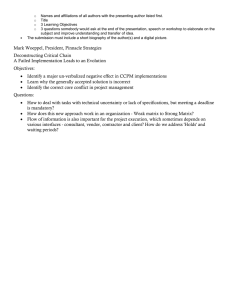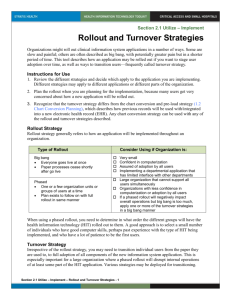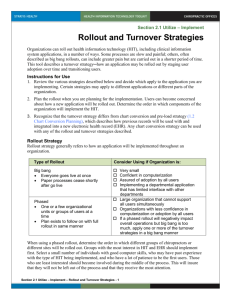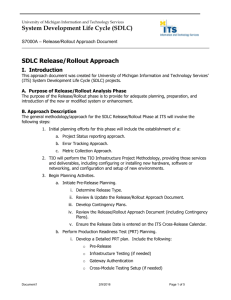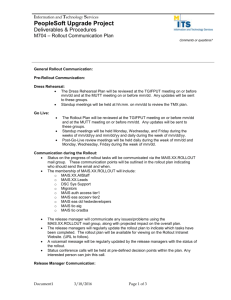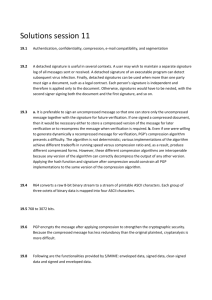Implementation
advertisement
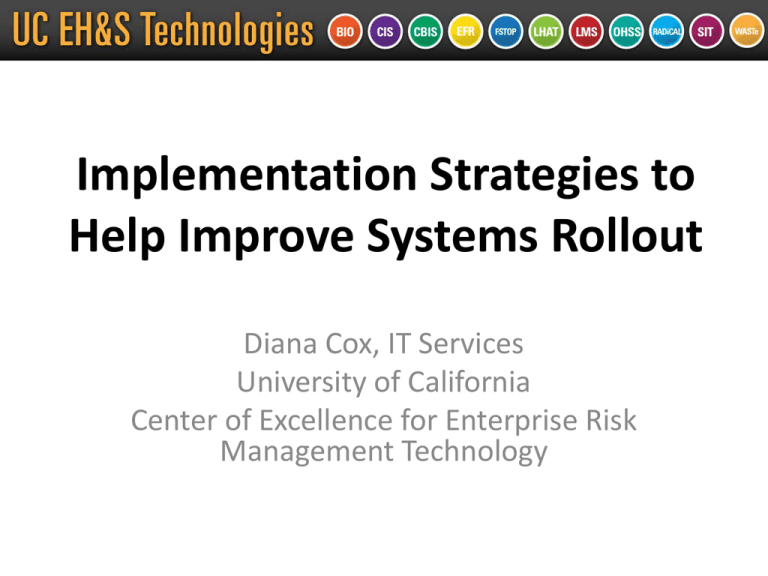
Implementation Strategies to Help Improve Systems Rollout Diana Cox, IT Services University of California Center of Excellence for Enterprise Risk Management Technology Objective Provide you with ideas and tools to help improve user adoption or the implementation process About IT Services • Systemwide development for EH&S and ERM • Full-Service Agile IT Shop – Development Teams • Scrum Master, QA, BA and Developers – System Administrators – Communications, Design, eLearning Team – Service Desk Experience with Software Implementations • Deployed 12 systems in 18 month span systemwide • Many lessons learned from each system rollout • Focused on continuous development, deployment and improvement Implementation Basics • Implementation starts when you begin developing your application • No two implementations will ever go the same • The best built software can fail if proper attention is not paid to the implementation • Implementing software requires a close and complex partnership between IT and the business users Top Ten Strategies and Tips for Smoother Implementations Counting down from 10… Engage Users Early and Often Do not start a project unless you have a dedicated Product Owner/Champion If a project is truly high priority then the resources from the business side should reflect this Involve stakeholders in weekly reviews and incorporate some of their feedback into the software If involvement declines, get people excited again Work towards a Common User Experience The more similar each module is, the less there is to relearn Efficiencies can be achieved faster If you are working on the first of many modules, plan for the future and start with a good foundation for the user experience Provide Flexibility in the Application Avoid customizations The campuses don’t interpret regulations the same or follow the same business practices i.e. Safety Inspection Tool: Can we have a flexible set of inspection questions? Can they be inspector based and also let a PI self-inspect? Can we inspect by building, floor, or PI? Training, Training, Training Train the administrators first Train the Trainer Train users Make training easy to access and succinct Provide many different methods Videos In-person training Webinars (here they are your friend) User guides/Cheat sheets Provide Implementation Kits Kits are intended to help the Admins of the system rollout the system to their customers Removes the stress of developing communication materials Includes: System access information Descriptive Infographic User guides Promotional fliers Email Text Website text Training documents Have a Single Point of Contact for Issues Customers/clients need to be able to talk to a person immediately if there is an issue Resolving issues quickly is critical Have a process to deal with defects vs. enhancement requests and communicate how each will be handled with the customer Over time, the help desk gains knowledge on how improve the system When possible, Integrate with Existing Systems The goal of software is to increase user efficiency The less duplicative data the customer has to enter, the better the experience Being able to view, add or remove data in only one system adds value Better data integrity, better reporting Implement a System only if it brings Value to the Customer Without value you have nothing Develop a 30 second elevator pitch for your software Use non-technical language to explain the benefits to functional users i.e. “It is a single page responsive app” vs “It can be used on any mobile device” Ask yourself, are you passionate about what it does/automates? Incentives Help – No/reduced cost to the campus – Free “stuff” if software is used – One-time import of existing data – High quality and complete data Admit Failure and Learn from it If the system isn’t well received, ask your customers why Ask for honest feedback Do not be defensive Use that information to shape your future implementation strategy Don’t be afraid to take risks Try new unconventional ways to engage users Your unhappy customers can become your best beta testers If it is required for your user to adopt the system, never make them feel like that is the case! Questions?

